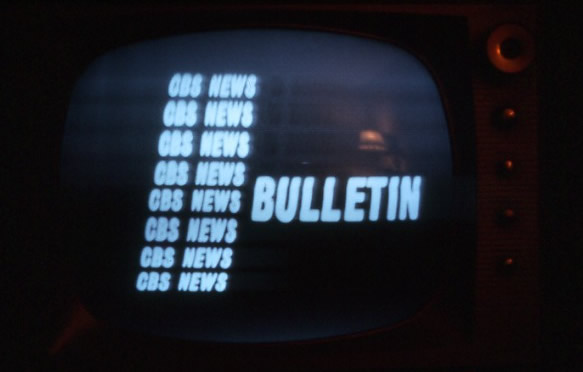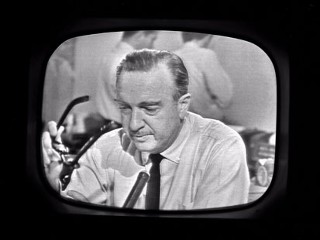 • YouTube isn’t quite as wonderful as it ought to be, but when it’s good, it’s really good. The other day, for instance, I discovered that it is now possible to view the first hour and a half of CBS’ live coverage of the assassination of President Kennedy–uncut.
• YouTube isn’t quite as wonderful as it ought to be, but when it’s good, it’s really good. The other day, for instance, I discovered that it is now possible to view the first hour and a half of CBS’ live coverage of the assassination of President Kennedy–uncut.
The first thing you see is the opening segment of As the World Turns, TV’s longest-running soap opera, complete with the original commercials. Then, without warning, the screen is filled with a CBS NEWS BULLETIN slide and you hear the once-familiar voice of Walter Cronkite breaking the bad news:
Here is a bulletin from CBS News. In Dallas, Texas, three shots were fired at President Kennedy’s motorcade in downtown Dallas. The first reports say that President Kennedy has been seriously wounded by this shooting. More details just arrived. These details about the same as previously: President Kennedy shot today just as his motorcade left downtown Dallas. Mrs. Kennedy jumped up and grabbed Mr. Kennedy, she called “Oh, no!”; the motorcade sped on. United Press says that the wounds for President Kennedy perhaps could be fatal. Repeating, a bulletin from CBS News, President Kennedy has been shot by a would-be assassin in Dallas, Texas. Stay tuned to CBS News for further details.
What you don’t see is Cronkite’s face. In 1963 the CBS newsroom in New York was not yet equipped with a “flash studio” that made it possible to air live pictures of whatever newsman was breaking into regular programming. Not for another twenty minutes did the network get its cameras warmed up and running.
 No less surprising is the fact that Cronkite was relying exclusively on wire-service copy, which he read more or less straight from the teletype. Dan Rather was on the scene in Dallas, but he wasn’t able to talk directly to Cronkite in New York, much less send him pictures. Throughout the next hour, Cronkite was forced to read and re-read wire-service reports and to hold up still photographs of the presidential motorcade, all of them transmitted by AP and UPI. Eventually we see live pictures from inside the Dallas Trade Mart, to which Kennedy had been en route. More than a half-hour after the first bulletin, Cronkite quotes Rather, who finally managed to get through to New York by telephone with an unconfirmed report that Kennedy was dead–but Rather is neither seen nor heard.
No less surprising is the fact that Cronkite was relying exclusively on wire-service copy, which he read more or less straight from the teletype. Dan Rather was on the scene in Dallas, but he wasn’t able to talk directly to Cronkite in New York, much less send him pictures. Throughout the next hour, Cronkite was forced to read and re-read wire-service reports and to hold up still photographs of the presidential motorcade, all of them transmitted by AP and UPI. Eventually we see live pictures from inside the Dallas Trade Mart, to which Kennedy had been en route. More than a half-hour after the first bulletin, Cronkite quotes Rather, who finally managed to get through to New York by telephone with an unconfirmed report that Kennedy was dead–but Rather is neither seen nor heard.
Fans of Mad Men don’t need to be told how much the world has changed since the Sixties, but I can’t think of a more telling example of how TV news has changed than this dusty ninety-minute time capsule.
